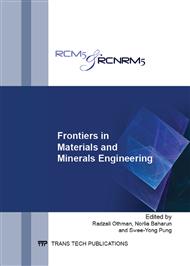[1]
D. Lata, Fabrication of Decorative Fluorescent Composite Material, Department of Physics National Institute Of Technology Rourkela, (2000) 6–7.
Google Scholar
[2]
Z. Jin, C. Khunlavit, H. Shuai, H. Chun, Wang, Hybrid composite laminates reinforced with glass/carbon woven fabrics for lightweight load bearing structures, Materials and Design 36 (2011) 75–80.
DOI: 10.1016/j.matdes.2011.11.006
Google Scholar
[3]
K. Sreejarani, Pillai, SR. Suprakas, Epoxy-based Carbon Nanotubes Reinforced Composites, National Centre for Nano-Structured Materials, CSIR South Africa (2000).
Google Scholar
[4]
B. Fiedler, F.H. Gojny, M.H. G Wichmann, M.C. M Nolte, K. Schulte, Fundamental aspects of nano-reinforced composites, Composites Science and Technology 66(16) (2006) 3115– 3125.
DOI: 10.1016/j.compscitech.2005.01.014
Google Scholar
[5]
K.K. Baljinder, B. Bhaskar, P. Dennis, R.A. Horrocks, Studies on the effect of different levels of toughener and flame retardants on thermal stability of epoxy resin, Polymer Degradation and Stability 95 (2010) 144–152.
DOI: 10.1016/j.polymdegradstab.2009.11.040
Google Scholar
[6]
S.S. Young, R.Y. Jae, Influence of Dispersion States of Carbon Nanotube on Physical Properties of Epoxy Nanocomposite, Carbon 43 (2005) 1378–1385.
Google Scholar
[7]
T.P. Chua, M. Mariatti, A. Azizan, A.R. Azura, The effect of surface functionalized multi-walled carbon nanotubes on the properties of poly(dimethyl siloxane) nanocomposites, Composite Science and Technology 70(4) (2010) 671–677.
DOI: 10.1016/j.compscitech.2009.12.023
Google Scholar
[8]
J-H. Lee, K.Y. Rhee, S.J. Park, Silane modification of carbon nanotubes and its effects on the material properties of carbon/CNT/epoxy three-phase composites, Composites: Part A 42 (2011) 478-483.
DOI: 10.1016/j.compositesa.2011.01.004
Google Scholar
[9]
W.M. Yeoh, K.Y. Lee, S.P. Chai, K.T. Lee, A.R. Mohamed, Synthesis of high purity multi-walled carbon nanotubes over Co-Mo/MgO catalyst by the catalytic chemical vapor deposition of methane, New Carbon Materials, Science Direct (2009) 119–122.
DOI: 10.1016/s1872-5805(08)60041-4
Google Scholar
[10]
T. Ogaswara, S.Y. Moon, Y. Inoue, and Y. Shimamura, Mechanical properties of aligned multi-walled carbon nanotube/epoxy composites processed using hot-melt prepeg method, Journal of Composites and Science and Technology: Elsevier, 71 (2011).
DOI: 10.1016/j.compscitech.2011.08.009
Google Scholar
[11]
P. Gajendran, and R. Saraswathi, Polyaniline-carbon nanotubes composite, Pure Application Chem, 80 (2008) 2377-2394.
Google Scholar
[12]
N.D. Greef, L. Gorbakith, S.V. Lomov, and I. Verpoest, Damage development in woven carbon fiber/epoxy composites modified with carbon nanotubes under tension in the bias direction, Journal of Composite: Elsevier, 42 (2011) 1635-1644.
DOI: 10.1016/j.compositesa.2011.07.013
Google Scholar
[13]
F. Laoutid, M. Alexandre, J.M. Lopez-Cuesta, P.H. Dubois, New prospects in flame retardant polymer materials: from fundamentals to nanocomposites, Mater Sci Eng 63(3) (2009) 100–25.
DOI: 10.1016/j.mser.2008.09.002
Google Scholar
[14]
T. Kashiwagi, F. Du, J.F. Douglas, K.I. Winey, R.H. Harris Jr., and J.R. Shields, Nanoparticle networks reduce the flammability of polymer nanocomposites, Nature materials, 4 (2005) 928-932.
DOI: 10.1038/nmat1502
Google Scholar


